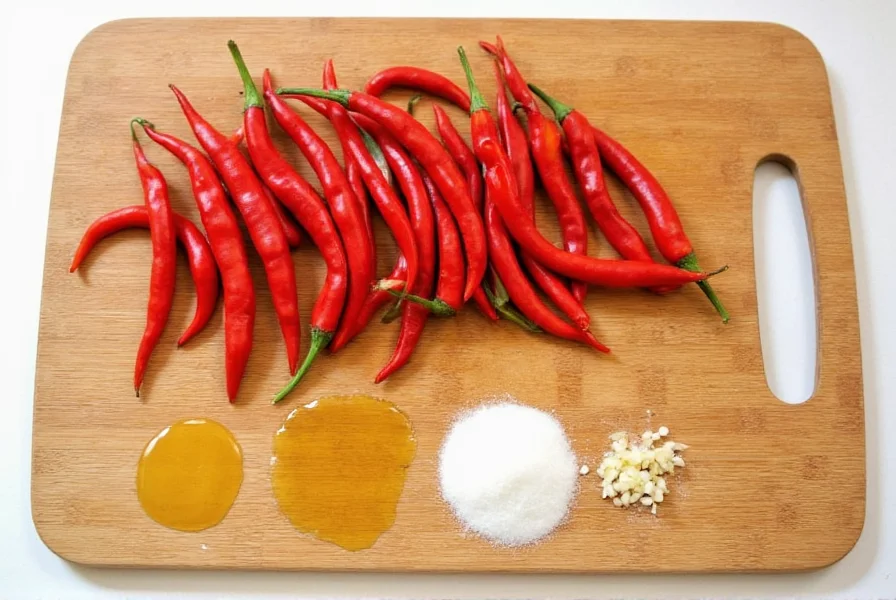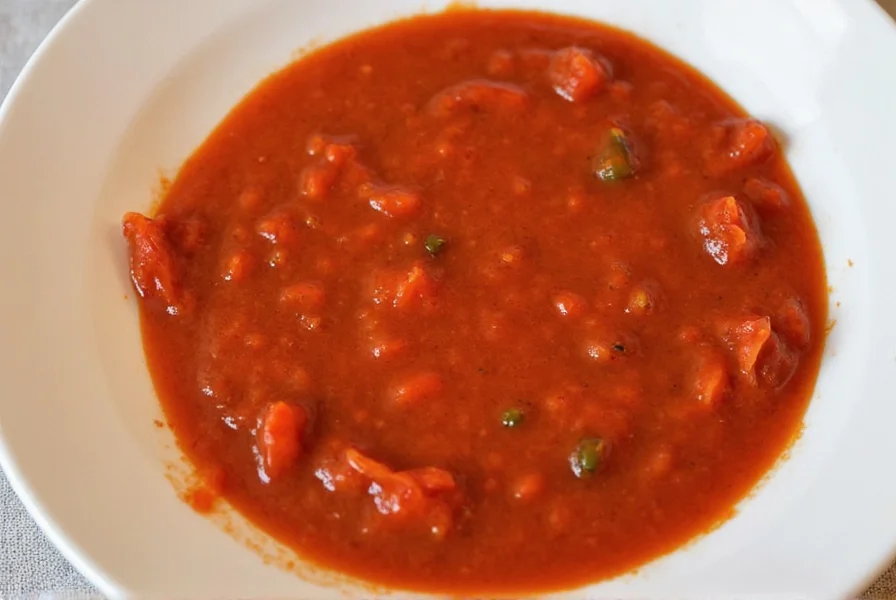Creating exceptional homemade chili sauce requires understanding the balance between heat, acidity, and sweetness. Unlike store-bought versions filled with preservatives and artificial flavors, a properly crafted chili sauce from scratch delivers vibrant, complex flavors that elevate any dish. This guide provides a versatile foundation you can adapt to your preferred heat level and culinary tradition, whether you're aiming for Mexican-style salsa roja, Thai nam prik, or a general-purpose hot sauce.
The Essential Homemade Chili Sauce Recipe
Follow this straightforward method for a balanced chili sauce that works as a dipping sauce, marinade, or cooking ingredient. The recipe's magic lies in the careful balance of fresh ingredients and proper cooking technique.
| Ingredient | Measurement | Preparation Notes |
|---|---|---|
| Fresh red chilies | 1 pound | Remove stems but keep seeds for maximum heat |
| Garlic cloves | 4 | Peeled and roughly chopped |
| Vinegar | 1 cup | White or apple cider vinegar works best |
| Water | 1/2 cup | Adjust for desired thickness |
| Sugar | 2 tablespoons | Adjust to taste and chili sweetness |
| Salt | 1 teaspoon | Plus more to taste after blending |
Step-by-Step Preparation Guide
Follow these precise steps for perfect chili sauce every time. The cooking process develops flavor while preserving the fresh character of the ingredients.
- Prepare chilies by removing stems but keeping seeds intact for maximum heat. Wear gloves if handling extremely hot varieties like habaneros.
- Combine all ingredients in a medium saucepan over medium heat.
- Bring to a gentle simmer (not a rolling boil) and cook for 15-20 minutes until chilies soften significantly.
- Remove from heat and cool slightly for 5 minutes before blending.
- Transfer to a blender and process until completely smooth (1-2 minutes).
- Taste and adjust seasoning with additional salt, sugar, or vinegar as needed.
- Strain through a fine-mesh sieve for ultra-smooth texture (optional).
- Store in sterilized glass bottles or airtight containers.

Why This Recipe Works: The Science Behind Great Chili Sauce
The success of this authentic chili sauce recipe stems from understanding food chemistry. Vinegar's acidity preserves the sauce while enhancing flavor extraction from chilies. The brief cooking time maintains fresh flavor while softening fibrous chili skins. Sugar balances acidity without making the sauce sweet, creating what chefs call "rounding out" the flavors.
Professional cooks know that proper emulsification occurs when blending hot (but not boiling) ingredients, creating a stable, uniform texture that won't separate. This explains why cooling slightly before blending yields superior results compared to processing boiling-hot mixtures.
Variations for Different Preferences and Cuisines
Adapt this basic recipe to create regional specialties or accommodate dietary preferences:
- Mild Family-Friendly Version: Substitute bell peppers for half the chilies and remove all seeds from remaining chilies. Add 1 roasted red bell pepper for sweetness.
- Mexican Salsa Roja: Add 2 roasted tomatoes and 1/4 teaspoon cumin. Use jalapeños or serranos as primary chilies.
- Thai-Style Nam Prik: Replace vinegar with lime juice, add 1 tablespoon fish sauce (or soy sauce for vegan), and include 1 tablespoon chopped galangal.
- Smoky Chipotle Sauce: Use 8 ounces chipotle peppers in adobo plus 8 ounces fresh red chilies for complex smokiness.
- Fruit-Infused Variation: Add 1/2 cup mango or pineapple during cooking for tropical sweetness that balances heat.
Storage and Usage Recommendations
Proper storage maintains flavor and safety. Homemade chili sauce without commercial preservatives requires careful handling:
- Refrigerate in airtight containers for up to 3 months
- For longer storage, freeze in ice cube trays then transfer cubes to freezer bags (up to 6 months)
- Always use clean utensils when handling to prevent contamination
- Signs of spoilage include mold, off odors, or bubbling
Culinary applications extend far beyond dipping. Use this versatile sauce as:
- Marinade base for proteins (add olive oil and citrus)
- Stir-fry flavor enhancer
- Pizza sauce alternative
- Base for Bloody Mary cocktails
- Ingredient in salad dressings

Troubleshooting Common Issues
Even experienced cooks encounter challenges with homemade chili sauce. Here's how to fix common problems:
- Sauce too thin: Simmer uncovered for additional 5-10 minutes to reduce, or add 1 teaspoon cornstarch mixed with 1 tablespoon cold water.
- Sauce too thick: Gradually add water or vinegar, 1 tablespoon at a time, until desired consistency.
- Too spicy: Balance with additional sugar (1 teaspoon at a time) or dairy like yogurt. Never add more chilies!
- Not spicy enough: Blend in small amounts of fresh minced chilies or cayenne pepper until desired heat level.
- Flavor too sharp: Let sauce rest for 24 hours in refrigerator; flavors will mellow and blend. Add 1/4 teaspoon baking soda if still too acidic.
Frequently Asked Questions
How long does homemade chili sauce last in the refrigerator?
Properly stored in an airtight container, homemade chili sauce maintains quality for 2-3 months in the refrigerator. Always use clean utensils when handling to prevent contamination. Discard if you notice mold, bubbling, or off odors.
Can I use dried chilies instead of fresh for this chili sauce recipe?
Yes, you can substitute dried chilies. Use 2 ounces dried chilies (about 10-12 large varieties) rehydrated in 2 cups hot water for 30 minutes. Reduce liquid in the recipe by 1/2 cup since rehydrated chilies add moisture. Dried chilies often provide deeper, more complex flavors than fresh.
Why does my chili sauce separate after refrigeration?
Separation occurs because natural oils in chilies rise to the top when chilled. This is normal and doesn't indicate spoilage. Simply stir or re-blend the sauce before use. For more stable emulsification, ensure you blend while ingredients are still warm (but not boiling) and consider adding 1/4 teaspoon xanthan gum during blending.
What's the best way to adjust heat level in homemade chili sauce?
Control heat by adjusting seed content - seeds contain most capsaicin. For milder sauce, remove all seeds; for hotter sauce, include them. You can also balance heat with sugar (1 teaspoon at a time) or dairy products. Remember that heat perception increases when sauce is cold, so taste at room temperature for accurate assessment.
Can I can this chili sauce for shelf-stable storage?
Yes, but proper canning technique is essential for safety. Use a water bath canner for 15 minutes with proper headspace. Ensure pH is below 4.6 (use a pH meter) by including sufficient vinegar. Only process in sterilized jars with proper seals. Improper canning can lead to botulism, so follow tested canning guidelines precisely.











 浙公网安备
33010002000092号
浙公网安备
33010002000092号 浙B2-20120091-4
浙B2-20120091-4